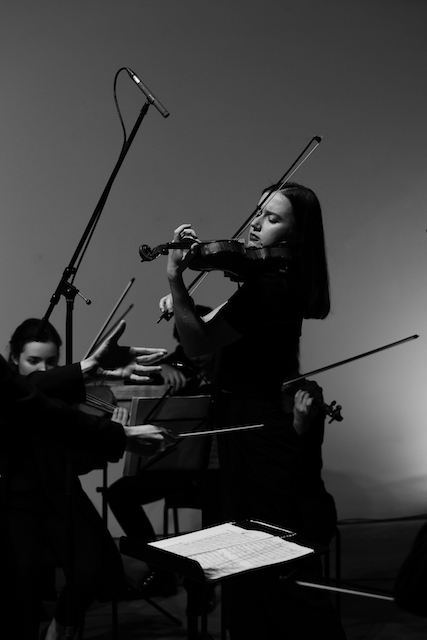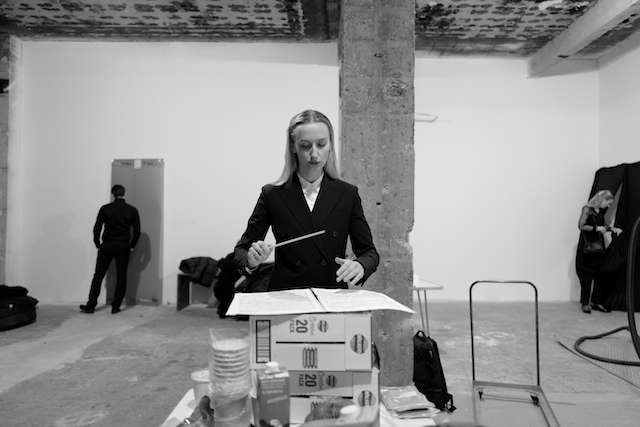Balanas Sisters, Anonimi Orchestra, The Bomb Factory, Marylebone review - talented Latvian conductor heads exciting new ensemble | reviews, news & interviews
Balanas Sisters, Anonimi Orchestra, The Bomb Factory, Marylebone review - talented Latvian conductor heads exciting new ensemble
Balanas Sisters, Anonimi Orchestra, The Bomb Factory, Marylebone review - talented Latvian conductor heads exciting new ensemble
The latest voice in the dialogue about what the future of classical music might look like
In an evening filled with "firsts" one of the many striking aspects was the effect the Anonimi Orchestra debut had on people walking past on the Marylebone Road. As we sat in the warehouse space of the Bomb Factory – with its exposed brick walls and large display windows – from time-to-time passers-by could be seen transfixed, gazing in at the vivacious ensemble bringing light to the January gloom.
The Anonimi Orchestra is the brainchild of Margarita Balanas, the cellist and conductor (main picture, and page bottom), one of three talented Latvian siblings who between them have collaborated with everyone from Anna-Sophie Mutter to Elton John. The self-deprecating name of the orchestra references their philosophy of putting the music before anything else; what this means in practice is a commitment to taking music out into the community and collaborating with innovative new composers. (A fascinating-sounding Carnival of Extinct Animals is in the works.)
The opening of the concert was Mozart’s Adagio and Fugue in C minor, originally composed for string quartet after Mozart had spent an intense period studying Bach’s contrapuntal style. For this first item, the orchestra alternated between magisterial dignity and whispery yearning in the opening Adagio before dispatching the Fugue with muscular elegance. Occasionally it felt that excitement and intensity were sacrificed for discipline and rigour. But the crescendo towards the conclusion was genuinely thrilling and showed what this orchestra could be like at full throttle.
The centrepiece was Mendelssohn’s Violin Concerto in D (as opposed to the more famous Concerto in E), a work written when he was 13 that was rediscovered by Yehudi Menuhin in the 1950s. It was a nice piece of programming, since at the point that Mendelssohn wrote this concerto he was widely considered to be a prodigy comparable only to Mozart. Though the overall tone is distinctively romantic, in the opening Allegro movement especially it’s possible to hear the intellectual dialogue Mendelssohn was having with Mozart in the arch wit and deft virtuosic flourishes. The way it’s performed is crucial, since it can make the difference between whether it comes across as a definitive work in its own right or simply an interesting piece of juvenilia.
 Luckily Margarita could call on her sister, the 33-year-old Kristine Balanas (pictured right, image by Kevin Kremer), who has already been praised by one broadsheet critic for her “eye-popping virtuosity”. (Her brother, Roberts, presumably would have been another option – he was only present as a cameraman and organiser for the evening, but he too is an astonishingly versatile violinist, as those who have seen him perform as a soloist will know.) As Roberts joined the passers-by on the Marylebone Road to film the concert through the windows, Kristine took centre-stage and the evening swung into a new gear. She demonstrated a resonant authority from the very first note, and the orchestra responded with vigour and agility.
Luckily Margarita could call on her sister, the 33-year-old Kristine Balanas (pictured right, image by Kevin Kremer), who has already been praised by one broadsheet critic for her “eye-popping virtuosity”. (Her brother, Roberts, presumably would have been another option – he was only present as a cameraman and organiser for the evening, but he too is an astonishingly versatile violinist, as those who have seen him perform as a soloist will know.) As Roberts joined the passers-by on the Marylebone Road to film the concert through the windows, Kristine took centre-stage and the evening swung into a new gear. She demonstrated a resonant authority from the very first note, and the orchestra responded with vigour and agility.
One of the unique features of the Marylebone Bomb Factory is that as an audience member you feel very much part of the cityscape that surrounds the venue. When you’re listening to the music, the number 2 and number 453 buses glide by, emerging like giant red sea monsters from the black of the night. As Kristine alternated between fleet fingered dynamism and Boadicean grandeur in the first movement it felt as if the traffic and people outside became part of the overall effect. (Though not in terms of noise, it should be emphasised.) The multiple reflections in the large windows heightened this sense: at one point it looked as if the people standing at the back of the hall were clustered on the pavement on the other side of the street.
In the Andante movement Kristine brought out both the elegance and sweet anguish of Mendelssohn’s vision, giving us a strong sense of the man who would go on to write the E minor concerto. In the arpeggiated sequences especially she brought out a gold-hued lyricism that held the audience spellbound. Then in the final Allegro she brought a more tempestuous energy to the music (making this critic wonder whether Storm Mendelssohn might be usefully added to our meteorologists’ ever-expanding name book). The flawlessly executed runs were superbly articulated as she skilfully ramped up the tension.
A surprise addition to the programme came with the Meditation from Massenet’s Thaïs, in which the whole auditorium seemed to resonate as the chords of the harp were supported by a sustained hum from the orchestra. It’s an easy crowd-pleaser, but again Kristine demonstrated her mettle as she balanced the soul-swooping upper melodies with grit and resolve in the lower passages.
The final work, Mahler’s Adagietto from Symphony No. 5, was a little ragged to start off with, but quickly picked up pace. This is a piece that has become famous through Leonard Bernstein’s interpretation for Robert Kennedy’s funeral, but far from being an expression of grief, it was originally written as a declaration of love for Alma, who he would later marry. The Anonimi Orchestra’s performance clung closely to the original spirit of the work, building from the sustained emotion of the beginning to full ecstatic fury. It rounded off a highly promising evening for a youthful ensemble with a dynamic vision that represents another exciting voice in the dialogue about what classical performance might look like for the future.
rating
Share this article
The future of Arts Journalism
You can stop theartsdesk.com closing!
We urgently need financing to survive. Our fundraising drive has thus far raised £49,000 but we need to reach £100,000 or we will be forced to close. Please contribute here: https://gofund.me/c3f6033d
And if you can forward this information to anyone who might assist, we’d be grateful.

Subscribe to theartsdesk.com
Thank you for continuing to read our work on theartsdesk.com. For unlimited access to every article in its entirety, including our archive of more than 15,000 pieces, we're asking for £5 per month or £40 per year. We feel it's a very good deal, and hope you do too.
To take a subscription now simply click here.
And if you're looking for that extra gift for a friend or family member, why not treat them to a theartsdesk.com gift subscription?
more Classical music
 Kempf, Brno Philharmonic, Davies, Bridgewater Hall, Manchester review - European tradition meets American jazz
Bouncing Czechs enjoy their Gershwin and Brubeck alongside Janáček and Dvořák
Kempf, Brno Philharmonic, Davies, Bridgewater Hall, Manchester review - European tradition meets American jazz
Bouncing Czechs enjoy their Gershwin and Brubeck alongside Janáček and Dvořák
 Solomon, OAE, Butt, QEH review - daft Biblical whitewashing with great choruses
Even a top soprano and mezzo can’t make this Handel paean wholly convincing
Solomon, OAE, Butt, QEH review - daft Biblical whitewashing with great choruses
Even a top soprano and mezzo can’t make this Handel paean wholly convincing
 Two-Piano Gala, Kings Place review - shining constellations
London Piano Festival curators and illustrious friends entertain and enlighten
Two-Piano Gala, Kings Place review - shining constellations
London Piano Festival curators and illustrious friends entertain and enlighten
 Echo Vocal Ensemble, Latto, Union Chapel review - eclectic choral programme garlanded with dance
Beautiful singing at the heart of an imaginative and stylistically varied concert
Echo Vocal Ensemble, Latto, Union Chapel review - eclectic choral programme garlanded with dance
Beautiful singing at the heart of an imaginative and stylistically varied concert
 Scott, Irish Baroque Orchestra, Whelan, RIAM, Dublin review - towards a Mozart masterpiece
Characteristic joy and enlightenment from this team, but a valveless horn brings problems
Scott, Irish Baroque Orchestra, Whelan, RIAM, Dublin review - towards a Mozart masterpiece
Characteristic joy and enlightenment from this team, but a valveless horn brings problems
 Classical CDs: Voice flutes, flugelhorns and froth
Baroque sonatas, English orchestral music and an emotionally-charged vocal recital
Classical CDs: Voice flutes, flugelhorns and froth
Baroque sonatas, English orchestral music and an emotionally-charged vocal recital
 Kanneh-Mason, Britten Sinfonia, Shave, Milton Court - a grin and a big beaming smile
A pair of striking contemporary pieces alongside two old favourites
Kanneh-Mason, Britten Sinfonia, Shave, Milton Court - a grin and a big beaming smile
A pair of striking contemporary pieces alongside two old favourites
 theartsdesk at the New Ross Piano Festival - Finghin Collins’ musical rainbow
From revelatory Bach played with astounding maturity by a 22 year old to four-hand jazz
theartsdesk at the New Ross Piano Festival - Finghin Collins’ musical rainbow
From revelatory Bach played with astounding maturity by a 22 year old to four-hand jazz
 First Person: Manchester Camerata's Head of Artistic Planning Clara Marshall Cawley on questioning the status quo
Five days of free events with all sorts of audiences around Manchester starts tomorrow
First Person: Manchester Camerata's Head of Artistic Planning Clara Marshall Cawley on questioning the status quo
Five days of free events with all sorts of audiences around Manchester starts tomorrow
 Goldscheider, Brother Tree Sound, Kings Place review - music of hope from a young composer
Unusual combination of horn, strings and electronics makes for some intriguing listening
Goldscheider, Brother Tree Sound, Kings Place review - music of hope from a young composer
Unusual combination of horn, strings and electronics makes for some intriguing listening

Add comment